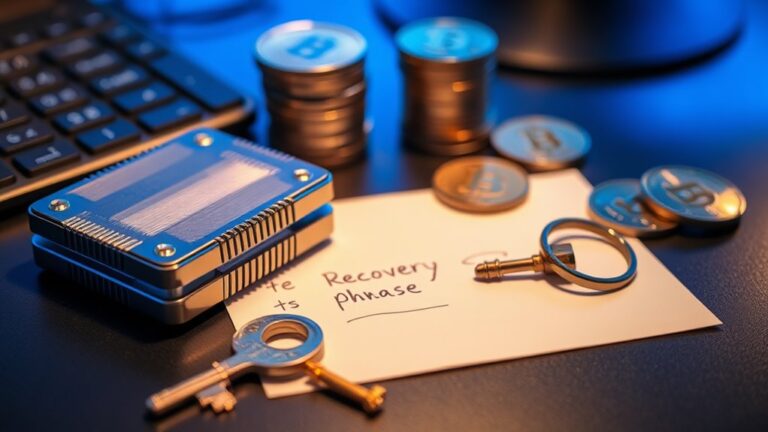Strategic Asset Allocation in Crypto
Note: This post may contain affiliate links, and we may earn a commission (with No additional cost for you) if you purchase via our link. See our disclosure for more info. The gold and crypto world is constantly changing. This is not financial, investment, legal, or professional advice. So, please verify the information on the gold and cryptocurrency provider’s websites.
Strategic asset allocation in crypto is all about balance, folks. Mix established players like Bitcoin and Ethereum with some edgy altcoins and DeFi tokens for spice. Diversification is your safety blanket against the wild volatility of this market. It's not just about chucking money everywhere, though—monitor sector performance and know where the risks lie. Embrace stablecoins as your calm during the storm. Curious about how to fine-tune your approach? There's a lot more to unpack here.

Steering through the wild world of cryptocurrency can feel like trying to ride a rollercoaster blindfolded—thrilling, but also a little terrifying. The stakes are high, and risk tolerance is your seatbelt. Evaluating financial goals, investment horizons, and emotional comfort with volatility is vital. It's like asking yourself, “How much chaos can I handle?” Risk assessment tools can quantify those tolerance levels, which is pretty handy. Don't forget to think about past investment experiences. If you panicked during your last market swing, you might want to rethink that crypto dream.
Navigating crypto feels like a thrilling, blindfolded rollercoaster ride—know your risk tolerance and brace for chaos.
Now, let's talk asset allocation strategies. The smart money puts the majority into established cryptocurrencies like Bitcoin and Ethereum for some stability. It's like having a safety net while you juggle. But don't forget the emerging projects—those altcoins and DeFi tokens could bring in the growth potential. Diversifying your portfolio across different assets can help mitigate risks associated with volatility. The FI Overage Portfolio Theory suggests that excess capital can be invested in more speculative assets, including cryptocurrencies.
And stablecoins? They're your liquidity lifesaver in this wild sea of volatility. Apply rules like the “50% Sell Rule” to lock in profits and don't forget to rebalance. It's like tidying up your messy room. Regular portfolio rebalancing is essential to maintain alignment with your investment goals, especially in the highly volatile crypto market.
Diversification across sectors is where it gets spicy. Spread your investments across DeFi, NFTs, and Layer 1/2 solutions. Keep an eye on sector performance trends. Those emerging use cases can make or break you. And, yes, you need to be aware of sector-specific risks. A little analysis never hurt anyone.
Portfolio optimization is a buzzword that sounds fancy, but it's significant. A 5% crypto allocation might optimize those risk-adjusted returns. Stress-test your allocations; it's like a workout for your portfolio. Keep it balanced and embrace low-correlation assets to enhance diversification.
Finally, market sentiment is a fickle friend. Timing is everything. Buy during downturns, sell during rallies, and avoid emotional trading like it's a bad habit. Stick to your plans, and maybe, just maybe, you'll ride this rollercoaster with a bit more grace.
Frequently Asked Questions
How Do I Choose the Right Cryptocurrencies for My Portfolio?
Choosing the right cryptocurrencies? It's a bit like picking a favorite child—harder than it sounds!
First, know your risk tolerance. Stick with big hitters like Bitcoin for safety, but don't shy away from some wild altcoins for potential wins.
Diversify, diversify, diversify. Sector bets matter too. DeFi, Layer 1, NFTs—there's a buffet of options.
Just remember, the market's a rollercoaster. Buckle up and enjoy the ride, or don't. Your call!
What Is the Ideal Percentage Allocation for Crypto Assets?
The ideal percentage for crypto assets? It's a mixed bag. Some say 5% of your net worth—just enough to keep things spicy without risking it all.
Others might push for 20-30% if you've got cash to burn. But hey, watch out! Crypto's a wild ride, and losses can hit hard.
Most folks stick to 1-5%, depending on their risk appetite. So, pick your poison wisely, or you might end up crying over spilled coins.
How Often Should I Rebalance My Crypto Portfolio?
Rebalancing a portfolio? It's like a dance—if you don't move, you'll get stuck in a rut.
Hourly rebalancing can boost growth by a whopping 234%. Daily? Not too shabby either, especially in bull markets.
But hey, it's a balancing act; frequent adjustments mean more fees.
Threshold strategies? They're like the smart kid in class, adapting to market swings while calendar methods are, well, predictable.
Choose wisely, or just hold on tight!
What Are the Tax Implications of Crypto Investments?
Crypto investments? Yeah, they come with tax implications that'll make your head spin.
Selling or spending crypto? Surprise! That's a taxable event.
And don't forget, mining or staking? Taxed as ordinary income.
Airdrops? Yep, taxed too, right when you get them.
No wash-sale rules mean you can offset losses like a champ.
Just remember, every transaction needs reporting.
So, keep those records tight.
Taxes and crypto? It's a wild ride, folks.
How Can I Mitigate Risks in My Crypto Allocation?
Mitigating risks in crypto isn't just a suggestion; it's survival.
First, spread those investments around. Don't put all your eggs in one digital basket—that's a disaster waiting to happen.
Use multiple exchanges. You know, just in case one decides to pull a disappearing act.
Embrace automated controls like stop-loss orders.
And hey, stay on top of market changes. Because if you're not watching, well, good luck with that!
Risks are lurking everywhere.













2 Comments